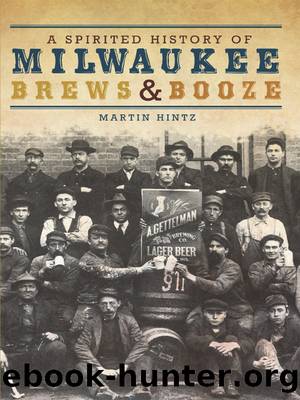A Spirited History of Milwaukee Brews and Booze by Martin Hintz

Author:Martin Hintz
Language: eng
Format: epub
Publisher: Arcadia Publishing Inc.
Published: 2012-08-14T16:00:00+00:00
NOTABLE MILWAUKEE BARS
Not long ago, a flatlander from New Lenox, Illinois, visited an in-law on Weil Street in what was once a Polish working-class neighborhood now called the more neutrally encompassing Riverwest. He stood in the middle of the intersection and marveled that there were taverns on each corner and one in the middle of every block as far as he could see. Each establishment had its own fiercely dedicated clientele.
In the early twentieth century, Milwaukee licensed 2,440 taverns, 6,767 bartenders, 2,630 pinball machines, seven horse-drawn junk wagons and fourteen handcarts. Author and Democratic political operative Harold Gauer published a series of books about growing up on Milwaukee’s East Side in the 1930s and 1940s, with some of his best tales focusing on the city’s taverns. “For some good souls, it was a confessional. For the depressed, it was a pool in which sorrow was drowned, and for boasters, appreciative listeners were always there. The tavern served all the purposes of the classic Greek marketplace, the desert oasis, and the baths of ancient Rome,” Gauer rhapsodized.36
In the 1930s, taverns were usually in clapboard buildings, unlike the more genteel tied houses of the previous generation—although schweinbacke (hog jowls) and bratwurst perfumed both. Among the better-known hideaways were Ernie & Mary’s, Frank & Sally’s, Sophie’s Place, Shorty’s Doghouse, Ma’s, Joe’s, Steve’s and others of that ilk. Emil Koeller’s roadhouse gardens on Green Bay Road offered plenty of cheek-to-cheek dancing when Belly Snider played the piano and Uncle Nats set forth on the drums. There, the waiters serving beers, Old Farm rye whiskey and sloe gin didn’t need any experience. The joke was that if wait staff applicants could walk without falling over their own feet, they got a job.37
Dirty Helen’s Sunflower Inn on St. Paul Avenue opened in 1926, serving no food but sneaking drinks to its more upscale clientele. During the Depression, “Dirty” Helen Cromwell, a devotee of Old Fitzgerald bourbon, gleefully served abundant amounts of what she exclaimed were “hard drinks for hard times.” The Sunflower shuttered in 1959. Peter and Mary Sigan opened Mary’s Log Cabin tavern and restaurant shortly after World War I at Clinton Street and Greenfield Avenue. It became a rooming house during Prohibition. Peter died in 1933, and typical of the day, his widow carried on, becoming noted among the factory workers at nearby Allen Bradley plant for her “Deep Fat Fried Chicken Jamboree” served on Saturday nights.38
During the late 1930s, up-and-coming young politicos, writers, musicians and artists congregated at Colla’s Five & Dime Tap near the near East Side tanneries. Owners Marcella and Francie Colla waterfalled giant tappers and served “Texas and Shoes,” their signature hamburger and shoestring potatoes. The place was popular, especially since a glass of wine was five cents, a mug of beer was ten cents and cocktails peaked at twenty-five cents. A hungry cub reporter from the Hearst-owned Milwaukee Sentinel could buy a hard-boiled egg for a nickel or a ham sandwich basted in beer sauce, sparked with ring of pineapple studded with cloves—all for ten cents.
Download
This site does not store any files on its server. We only index and link to content provided by other sites. Please contact the content providers to delete copyright contents if any and email us, we'll remove relevant links or contents immediately.
| Africa | Americas |
| Arctic & Antarctica | Asia |
| Australia & Oceania | Europe |
| Middle East | Russia |
| United States | World |
| Ancient Civilizations | Military |
| Historical Study & Educational Resources |
The Dawn of Everything by David Graeber & David Wengrow(1571)
The Bomber Mafia by Malcolm Gladwell(1523)
Facing the Mountain by Daniel James Brown(1429)
Submerged Prehistory by Benjamin Jonathan; & Clive Bonsall & Catriona Pickard & Anders Fischer(1376)
Tip Top by Bill James(1291)
Wandering in Strange Lands by Morgan Jerkins(1283)
Evil Geniuses: The Unmaking of America: A Recent History by Kurt Andersen(1272)
Red Roulette : An Insider's Story of Wealth, Power, Corruption, and Vengeance in Today's China (9781982156176) by Shum Desmond(1267)
The Way of Fire and Ice: The Living Tradition of Norse Paganism by Ryan Smith(1259)
Driving While Brown: Sheriff Joe Arpaio Versus the Latino Resistance by Terry Greene Sterling & Jude Joffe-Block(1231)
American Kompromat by Craig Unger(1214)
F*cking History by The Captain(1197)
It Was All a Lie by Stuart Stevens;(1193)
American Dreams by Unknown(1155)
Treasure Islands: Tax Havens and the Men who Stole the World by Nicholas Shaxson(1153)
Evil Geniuses by Kurt Andersen(1144)
White House Inc. by Dan Alexander(1123)
The First Conspiracy by Brad Meltzer & Josh Mensch(1076)
The Fifteen Biggest Lies about the Economy: And Everything Else the Right Doesn't Want You to Know about Taxes, Jobs, and Corporate America by Joshua Holland(1031)
